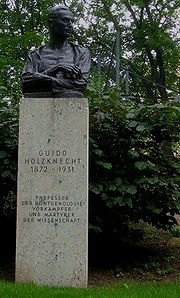
Guido Holzknecht
Encyclopedia

Vienna
Vienna is the capital and largest city of the Republic of Austria and one of the nine states of Austria. Vienna is Austria's primary city, with a population of about 1.723 million , and is by far the largest city in Austria, as well as its cultural, economic, and political centre...
. He studied in Strasbourg
Strasbourg
Strasbourg is the capital and principal city of the Alsace region in eastern France and is the official seat of the European Parliament. Located close to the border with Germany, it is the capital of the Bas-Rhin département. The city and the region of Alsace are historically German-speaking,...
, Königsberg
Königsberg
Königsberg was the capital of East Prussia from the Late Middle Ages until 1945 as well as the northernmost and easternmost German city with 286,666 inhabitants . Due to the multicultural society in and around the city, there are several local names for it...
and Vienna, and in 1905 became director of the X-ray laboratory at Vienna General Hospital. He later extablished a central radiology
Radiology
Radiology is a medical specialty that employs the use of imaging to both diagnose and treat disease visualized within the human body. Radiologists use an array of imaging technologies to diagnose or treat diseases...
department at the hospital, which became known as the "Guido Holzknecht Institute". With radiologist Robert Kienböck
Robert Kienböck
Robert Kienböck was an Austrian radiologist who was a native of Vienna.In 1895 he earned his medical doctorate at the University of Vienna, and spent the next year abroad. He returned to Vienna as an assistant to Leopold von Schrötter , a laryngologist, and began working in the new science of...
(1871-1953), he was co-founder of the Wiener Röntgengesellschaft (Vienna Radiology Society).
The statue of Holzknecht in Arne Carlsson Park was originally made by Josef Josephu. Damaged during the war, it was later restored incorrectly. The family had commissioned Josephu to show missing fingers -- fingers Holzknecht lost due to radiation poisoning. The restored statue (pictured right) shows all his fingers intact; so the statue was restored and the man healed.
Guido Holzknecht was a pioneer in the field of radiology, and in 1902 devised a dosimeter
Dosimeter
Dosimeters measure an individual's or an object'sexposure to something in the environment — particularly to a hazard inflicting cumulative impact over long periods of time, or over a lifetime...
called a "chromoradiometer". Like a number of other physicians in the early days of radiology, he died from the consequences of radiation damage
Radiation poisoning
Acute radiation syndrome also known as radiation poisoning, radiation sickness or radiation toxicity, is a constellation of health effects which occur within several months of exposure to high amounts of ionizing radiation...
.
Associated eponym
- Holzknecht's space: Also known as retro-cardiac space. It is located between the posterior wall of the heartHeartThe heart is a myogenic muscular organ found in all animals with a circulatory system , that is responsible for pumping blood throughout the blood vessels by repeated, rhythmic contractions...
and the vertebral column.
Selected writings
- Röntgenologische Diagnostik der Erkrankung der Brusteingeweide (Radiological Diagnostics of Breast CancerBreast cancerBreast cancer is cancer originating from breast tissue, most commonly from the inner lining of milk ducts or the lobules that supply the ducts with milk. Cancers originating from ducts are known as ductal carcinomas; those originating from lobules are known as lobular carcinomas...
), 1901 - Röntgendiagnostik des Magenkrebses (1905).
- Röntgenologie, 2 vols., (Radiology) 1918/1924
- Röntgentherapie, (X-Ray Therapy) 1924
- Einstellung zur Röntgenologie, (Attitudes to Radiology) 1927
- Handbuch der theoretischen und klinischen Röntgenkunde, 2 vols., (Handbook of Theoretical and Clinical X-Ray Studies), (1929).

